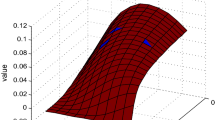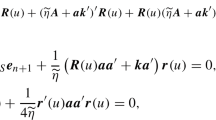Abstract
We consider the problem of optimal position liquidation where the expected cash flow stream due to transactions is maximized in the presence of temporary or permanent market impact. A stochastic programming approach is used to construct trading strategies that differentiate decisions with respect to the observed market conditions, and can accommodate various types of trading constraints. As a scenario model, we use a collection of sample paths representing possible future realizations of state variable processes (price, trading volume etc.), and employ a heuristical technique of sample-path grouping, which can be viewed as a generalization of the standard nonanticipativity constraints.
Similar content being viewed by others
References
Almgren, R. and N. Chriss. (2000). “Optimal Execution of Portfolio Transactions.” Journal of Risk, 3, 5–39.
Almgren, R. (2003). “Optimal Execution with Nonlinear Impact Functions and Trading-Enhanced Risk.” Applied Mathematical Finance, 10, 1–18.
Barraquand, J. and D. Martineau. (1995). “Numerical Valuation of High Dimensional Multivariate American Securities.” Journal of Financial and Quantitative Analysis, 30, 382–405.
Bertsimas, D. and A. Lo. (1998). “Optimal Control of Execution Costs.” Journal of Financial Markets, 1, 1–50.
Bertsimas, D., A. Lo, and P. Hummel. (1999). “Optimal Control of Execution Costs for Portfolios.” Computing in Science and Engineering November/December, 40–53.
Birge, J.R. and F. Louveaux. (1997). Introduction to Stochastic Programming. New York: Springer.
Bogentoft, E., H.E. Romeijn, and S. Uryasev. (2001). “Asset/Liability Management for Pension Funds Using CVaR Constraints.” The Journal of Risk Finance, 3(1), 57–71.
Boyle, P., M. Broadie, and P. Glasserman. (1997). “Monte-Carlo Methods for Security Pricing.” Journal of Economic Dynamics and Control, 21, 1267–1321.
Broadie, M. and P. Glasserman. (1997). “Pricing American-Style Securities Using Simulations.” Journal of Economic Dynamics and Control, 21, 1323–1352.
Butenko, S., A. Golodnikov, and S. Uryasev. (2003). “Optimal Security Liquidation Algorithms.” Research Report # 2003–1, ISE Dept., University of Florida.
Carriere, J.F. (1996). “Valuation of the Early-Exercise Price for Derivative Securities Using Simulations and Splines.” Insurance: Mathematics and Economics, 19, 12–30.
Chan, L. and J. Lakonishok. (1995). “The Behavior of Stock Prices Around Institutional Trades.” Journal of Finance, 50, 1147–1174.
Hartman, P. (1959). “On Functions Representable as a Difference of Convex Functions.” Pacific Journal of Mathematics, 9, 707–713.
Hibiki, N. (1999). “Multi-Period Stochastic Programming Models for Dynamic Asset Allocation.” Proceedings of International Conference on Stochastic Systems Theory and Its Applications, Yokogama.
Hibiki, N. (2001). “A Hybrid Simulation/Tree Stochastic Optimization Model for Dynamic Asset Allocation.” JAFFEE Journal, 1, 89–119 [in Japanese].
Horst, R., P.M. Pardalos, and N.V. Thoai. (2000). Introduction to Global Optimization. New York: Kluwer Academic Publishers.
Horst, R. and N.V. Thoai. (1999). “DC Programming: Overview.” Journal of Optimization Theory and Applications, 103(1), 1–43.
Kein, D.B. and A. Madhavan. (1995). “Anatomy of the Trading Process: Empirical Evidence on the Behavior of Institutional Traders.” Journal of Financial Economics, 37, 371–398.
Konno, H. and A. Wijayanayake. (1999). “Mean-Absolute Deviation Portfolio Optimization Model under Transaction Costs.” Journal of the Operation Research Society of Japan, 42, 422–435.
Kraus, A. and H. Stoll. (1972). “Price Impacts of Block Trading on the New York Stock Exchange.” Journal of Finance, 27, 569–588.
Krokhmal, P., J. Palmquist, and S. Uryasev. (2002). “Portfolio Optimization with Conditional Value-at-Risk Objective and Constraints.” Journal of Risk, 4, 43–68.
Rickard, J.T. and N.G. Torre. (1999). “Optimal Transaction Implementation.” Journal of Management Information Systems, 16, 47–62.
Rockafellar, R.T. and S. Uryasev. (2000). “Optimization of Conditional Value-at-Risk.” Journal of Risk, 2, 21–41.
Rockafellar, R.T. and S. Uryasev. (2002). “Conditional Value-at-Risk for General Loss Distributions.” Journal of Banking and Finance, 26, 1443–1471.
Titley, J.A. (1993). “Valuing American Options in a Path Simulation Model.” Transactions—Society of Actuaries, 45, 499–520.
Tuy, H. (1994). “D. C. Optimization: Theory, Methods, and Algorithms.” In R. Horst and P. Pardalos (eds.), Handbook of Global Optimization. Dordrecht: Kluwer Academic Publishers.
Tuy, H. (2000). “On Some Recent Advances and Applications of D.C. Optimization.” In V.H. Nguyen et al. (eds.), Optimization, Lecture Notes in Economics and Mathematical Systems, Vol. 481, Springer, pp. 473–497.
Author information
Authors and Affiliations
Corresponding author
Rights and permissions
About this article
Cite this article
Krokhmal, P., Uryasev, S. A sample-path approach to optimal position liquidation. Ann Oper Res 152, 193–225 (2007). https://doi.org/10.1007/s10479-006-0143-3
Published:
Issue Date:
DOI: https://doi.org/10.1007/s10479-006-0143-3




